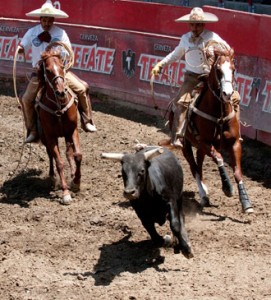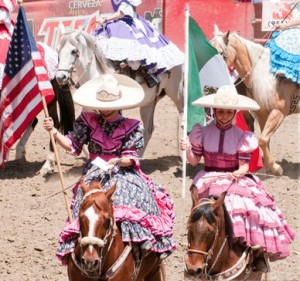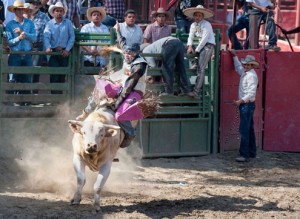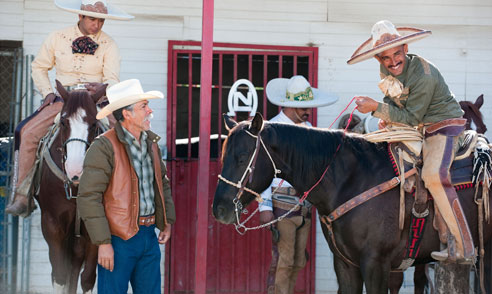Charro ‘Life’
By Paula Parisi June 24, 2011Charreada gets a cameo in Chris Weitz’ film A Better Life, which opens today from Summit Entertainment. The plot centers on the relationship between a Mexican gardener and his teenage son, who hovers precipitously on the edge of gang life. Illegals living in Los Angeles, they move through a sort of shadow world, struggling to stay below the radar. As the two traverse the city in search of the family’s stolen truck, audiences get a tour of Hispanic hotspots, from restaurants and bars to the Festival Carnaval Y Charreada ― Mexican rodeo ―at the Sports Arena in Pico Rivera.

A Better Life director Chris Weitz captured authentic charreada footage in Pico Rivera.(Photo by Merrick Morton / Summit Entertainment)
Surprised to find charreada only 30 miles outside Los Angeles, Weitz in an interview with NPR’s “Morning Edition,” described the impression made by the charros and charrearas: “They show their skills in these absolutely gorgeous costumes; beautiful brocaded outfits with sombreros. And the women ride in sidesaddle in these beautiful, poofy skirts in kind of these coordinated equestrian ballets. It is really something quite extraordinary.” Interviewer Renee Montagne concurred, calling the scene “a lovely moment in the film.”
There are more than 1,000 charreada organizations in Mexico, and about 80 in the U.S., with events taking place in Texas, Maine, Illinois, New Mexico and Arizona ― and closer to home, at the Hansen Dam Equestrian Center, which drew a crowd of more than 1,000 to an exhibition last June.
Animal rights activists condemn certain aspects of the charreada. “Horse tripping,” historically the most objectionable of the displays, has been voluntarily banned by official charro organizations since 1995. Though the traditional charreada program still includes “foreleg catching,” attempts to trip or otherwise cause the horse to fall results in a fine and one-year suspension.
California, Maine, New Mexico, and Texas have outlawed the practice outright (though it’s a misdemeanor). It is also illegal in some Arizona and Nevada counties, though there are those who still practice the cruel sport, and defend it as safe and historically relevant (having once been a ranching skill).

Colorful charreara perform riding drills, known as escaramuza, a highlight of any Mexican rodeo. (Photo by Merrick Morton / Summit Entertainment)
Legitimate producers of Mexican rodeo take obvious pride in maintaining the health and safety of the animals, and spectators shouldn’t have any difficulty determining whether this is the case. The Charros Federation USA proclaims “countless hours of training” and the expenditure of many thousands of dollars “to learn to execute competition in a controlled, safe and professional manner.”
A traditional charreada begins to the beat of a live brass band. The formal program usually begins with an introductory parade and the ceremonial “charro Prayer,” an appreciation of the lives of the horses, cattle and riders.
The traditional 10 events are:
Cala de caballo – reining and training demonstration
Piales – horse heel roping from horseback
Colas – steer tailing
Escaramuza – charreara teams compete and display riding skills in beautiful dresses and fancy traditional attire
Jineteo de toro – bull riding
Terna en el ruedo – team steer roping
Jineteo de Yegua – bareback bronc riding

Bull riding requires equal parts bravery and athleticism. (Photo by Merrick Morton / Summit Entertainment)
Manganas a Pie – foreleg horse catching on foot
Manganas a Caballo – foreleg horse catching from horseback
Paso de la muerte – the “jump of death” The charro jumps from the bare back of his own riding horse onto the bare back of a running bronc, with just the mane to hold onto. He has to stay on until the wild horse stops bucking and must dismount gracefully and without help
Charrerada goes back to the last years of the Mexican revolutionary period. Owners of Haciendas organized practical ranch labor events and the charros consistently added art, talent and gallantry to the everyday chores of practical ranch life, and enjoyed exhibiting and honing their skills in competitive events. The charro tradition also extends to elaborately decorated tack, hand-tooled and trimmed in silver. Everything the charro wears in the competition arena must follow standards set by the governing bodies, down to the colors of the custom-made attire, including sombrero and boots. Traditional Mexican food and dancing are also part of the family fun that National Charro Day has been officially proclaimed September 14th, in Mexico and in the United States (where it falls during Latino Heritage Month).
To read Chris Weitz’ interview with Renee Montagne click here.
To visit the official movie website for A Better Life click here.
For more information about charreada, visit www.charrosfederationusa.com

Hand-tooled saddles and bespoke garments are a hallmark of the charro. (Photo by Merrick Morton / Summit Entertainment)
Short URL: https://theequestriannews.com/?p=2858


